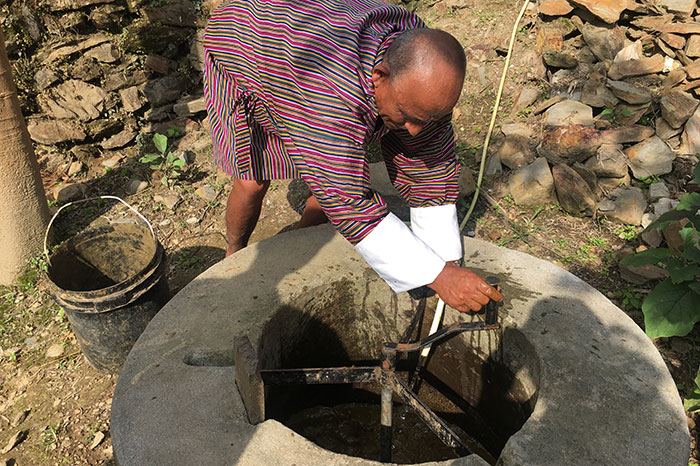Chimi Dema | Semjong
Even if the country locks down for a year, Nar Bahadur Barailey and his family need not worry about running out of liquified petroleum gas (LPG).
The farmer from Dzomling chiwog in Semjong, Tsirang used to consume at least six LPG cylinders a year for cooking in the past. But since last year, the family hasn’t consumed even a single refilled cylinder.
The family has found a reliable and cheap substitute in the small biogas plant using cattle dung he constructed last year.
Nar Bahadur Barailey could save about Nu 6,000 in a year on refilling the LPG cylinders.
“The biogas plant is a one-time investment and reliable energy,” said the 71-year-old farmer.
Apart from saving fuel expenses, he said that the construction of a biogas plant has helped bypass their struggles to get LPG refilled.
Earlier Nar Bahadur Barailey had to travel to Damphu town, obtain a token and wait in the queue for hours to get the cylinder refilled or sometimes go back home empty-handed when the depot ran out of stock.
He uses about 25kg of cattle dung to produce enough gas to sustain his family for a day.
“Besides, the organic manure helps in growing vegetables and cardamom,” he said. “So far, my plant has been serving the purpose well.”
The gewog has 67 biogas plants today and Dzomling chiwog with 25 plants has the highest among the five chiwogs.
Many biogas plants in the gewog had cost between Nu 30,000 to Nu 45,000 to construct. Farmers received a subsidy of 50 percent from the government and they invested the remaining half.
Another farmer from the same chiwog, Devi Charan Gajmer said that using biogas fuel has helped ease pressure on the community forest by reducing firewood consumption.
“Rearing cattle for energy production and I can also sell the surplus dairy products,” he said. “So far, I have no complaints with my biogas plant.”
A farmer in Tashiling Toed, Mon Bahadur Saru said that the firewood is consumed only to cook for his livestock now.
Although the project began in 2013, only 33 households constructed the biogas plant over the past six years.
Gewog livestock health supervisor, Bishal Rai said that it was only from last year that more residents began to take interest in biogas plants.
“With the increasing subsidy support from the government and given the shortage of LPG cylinders in the market last year, people’s interest in biogas grew,” he said.
“We have installed 34 plants in the last fiscal year alone.”
In addition, understanding the efficiency of the energy and the use of its output, organic manure has also motivated farmers, said Bishal Rai.
In an effort to promote more biogas plants, the gewog administration has also allocated budget to support two plants in this fiscal year.
Bishal Rai said that should more interested individuals come forward, the gewog livestock extension would propose for the budget.
“There were a few villagers who showed interest last year however, we couldn’t support them because the programme ended,” he said.
The construction of the plants for this fiscal year is expected to begin in December.
Today, the dzongkhag has about 400 biogas plants. Of the 12 gewogs in the dzongkhag, Semjong has the most number of plants.
The focal person for biogas with the Livestock Sector in Tsirang, Yam Bahadur Monger said that constructing a biogas plant is one of major activities of the sector in the current plan.
“The livestock sector has a target to install 30 plants every year in the 12th plan,” he said.
He said that given the subsidies on electricity and LPG, not many people take the opportunity to construct biogas plants.
Skilled labour shortage is another challenge, he said.


